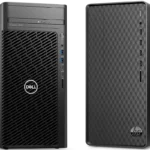Cameras help people capture important moments and express creativity through photography. A good camera can make the difference between an okay photo and a great one. Some brands have earned respect for making reliable and high-quality cameras over many years.
When buying a camera, pay attention to image quality, ease of use, and price. Image quality depends on the sensor size and lens quality. Ease of use matters for beginners who don’t want complicated settings. Price is important too since cameras can cost from a few hundred to several thousand dollars.
We spent many hours testing and researching cameras from different brands to find which ones offer the best quality and value for different types of photographers.
Top Camera Brands for 2025
1. Sony – The Innovation Pioneer
Best For: Mirrorless technology, video content creation, professional photography
Sony continues to lead the mirrorless revolution with cutting-edge sensor technology and exceptional performance (source: RTINGS). Their 2025 strengths include:
- Industry-leading autofocus systems with real-time tracking
- Exceptional low-light performance across all camera categories
- Professional video capabilities with 8K recording and advanced codecs
- Comprehensive lens ecosystem from ultra-wide to super-telephoto
- Innovative features like in-body image stabilization and silent shooting
Popular 2025 Models: α7R V, α7 IV, FX30, α6700
2. Canon – The Versatile All-Rounder
Best For: Portrait photography, beginners to professionals, reliable performance
Canon maintains its reputation as the most versatile brand, excelling across all photography genres (source: Camera Brands). Key advantages include:
- Outstanding color science particularly for skin tones and portraits
- Extensive product lineup from entry-level to flagship professional cameras
- Robust build quality designed for demanding professional use
- User-friendly interfaces making advanced features accessible
- Massive lens selection including legendary L-series glass
Standout Features: Dual Pixel autofocus, weather sealing, ergonomic design
3. Nikon – The Rugged Reliability Champion
Best For: Landscape photography, outdoor adventures, traditional DSLR users
Nikon has successfully transitioned to mirrorless while maintaining their reputation for durability (source: Camera Brands). Their 2025 advantages include:
- Exceptional build quality for extreme weather conditions
- Outstanding image quality with natural color reproduction
- Professional-grade ergonomics for extended shooting sessions
- Strong Z-mount lens system with impressive optical performance
- Reliable performance trusted by photographers worldwide
Notable Strengths: Weather resistance, battery life, traditional photographer workflow
4. Fujifilm – The Creative Specialist
Best For: Street photography, film simulation enthusiasts, compact systems
Fujifilm stands out with unique color science and photographer-focused features (source: Expert Photography). Their distinctive approach includes:
- Legendary film simulation modes replicating classic film stocks
- Exceptional JPEG output straight from camera
- Compact, premium build quality with retro aesthetics
- Outstanding APS-C sensors competing with full-frame performance
- Creative controls that inspire artistic photography
Special Features: Film simulations, manual control dials, compact form factors
5. Panasonic – The Video Powerhouse
Best For: Videographers, hybrid content creators, professional video production
Panasonic excels in video-centric features while maintaining strong photography capabilities (source: Tom’s Guide Awards). Key strengths include:
- Professional video features including unlimited recording time
- Advanced color profiles for professional video production
- Robust codec support including ProRes and RAW video
- Excellent stabilization for handheld video work
- Weather-sealed construction for demanding environments
6. Olympus/OM System – The Compact Performance Leader
Best For: Travel photography, wildlife, photographers wanting smaller systems
The Micro Four Thirds system offers unique advantages for specific use cases:
- Compact, lightweight systems without compromising image quality
- Exceptional in-body stabilization enabling handheld long exposures
- Impressive telephoto reach with smaller, lighter lenses
- Weather-resistant design across the entire system
- Innovative computational photography features
Brand Specializations and Strengths
Professional Photography Focus:
Sony & Canon lead in professional markets with comprehensive ecosystems supporting everything from wedding photography to sports journalism (source: Camera Digital).
Content Creation Excellence:
Sony and Panasonic dominate video-focused applications, while Canon excels in hybrid photo/video scenarios.
Beginner-Friendly Options:
Canon and Nikon offer the most intuitive learning curves, with extensive educational resources and user-friendly interfaces (source: Expert Photography).
Creative Photography:
Fujifilm stands alone in offering film-inspired shooting experiences and exceptional creative controls.
What Professional Photographers Say About 2025 Brands
Professional photographers reveal key insights about brand preferences (source: Camera Digital):
Most Trusted for Reliability:
- Nikon for extreme weather and challenging conditions
- Canon for consistent performance across diverse shooting scenarios
- Sony for cutting-edge technology and innovation
Best Investment Value:
- Sony for future-proofing with latest technology
- Canon for long-term ecosystem stability
- Fujifilm for unique creative capabilities
Workflow Integration:
- Canon and Nikon for traditional photography workflows
- Sony for modern, tech-forward approaches
- Panasonic for professional video production pipelines
Choosing the Right Brand for Your Needs
For Beginners Starting Their Photography Journey:
Recommendation: Canon or Sony
- Extensive learning resources and community support
- Wide range of affordable lenses and accessories
- User-friendly interfaces with room to grow (source: PCMag)
For Professional Photographers:
Recommendation: Sony, Canon, or Nikon
- Comprehensive professional ecosystems
- Reliable performance under pressure
- Extensive service and support networks
For Content Creators and Videographers:
Recommendation: Sony or Panasonic
- Advanced video features and capabilities
- Professional codec support
- Excellent low-light performance for diverse shooting conditions
For Travel and Street Photography:
Recommendation: Fujifilm or Olympus/OM System
- Compact, lightweight systems
- Discreet shooting capabilities
- Excellent image quality in portable packages
For Wildlife and Sports:
Recommendation: Sony or Canon
- Fast, accurate autofocus systems
- Extensive telephoto lens options
- High-speed continuous shooting capabilities
2025 Market Trends and Innovations
Key Technological Advances:
Leading brands are focusing on (source: RTINGS):
- Computational photography integration
- AI-powered autofocus with subject detection
- Enhanced video capabilities across all camera categories
- Improved battery life and charging solutions
- Better connectivity for modern workflow integration
Ecosystem Considerations:
Modern camera choice involves considering the entire ecosystem (source: Expert Photography):
- Lens selection and future roadmaps
- Accessory availability and third-party support
- Software integration and workflow compatibility
- Service and support network accessibility
Making Your Brand Decision
Critical Factors to Evaluate:
- Primary Photography Style – Match brand strengths to your interests
- Budget Range – Consider long-term lens and accessory investments
- Experience Level – Choose brands with appropriate learning curves
- Future Goals – Select systems that can grow with your skills
- Workflow Preferences – Ensure compatibility with your editing and sharing processes
Professional Recommendations:
Photography experts consistently advise (source: PCMag):
- Try before buying – Handle cameras in person when possible
- Consider the ecosystem – Cameras are long-term investments
- Focus on your needs – Don’t chase specifications you won’t use
- Plan for growth – Choose systems with expansion possibilities
Bottom Line
The camera market in 2025 offers exceptional options across all brands and price points (source: Tom’s Guide Awards). Each major brand has developed distinct strengths: Sony leads in innovation, Canon excels in versatility, Nikon provides rugged reliability, Fujifilm offers creative inspiration, and Panasonic dominates video capabilities.
Your ideal brand choice depends on matching these strengths to your specific photography goals, experience level, and creative vision. With proper selection from any of these top-tier brands, you’ll have the tools needed to capture and create exceptional images for years to come.
The key is understanding that in 2025, you can’t go wrong with any major brand – the differences lie in which approach best matches your photographic journey and creative aspirations.
Best Camera Brands
We’ve rounded up the top camera brands for all your photography needs. These trusted names offer quality, innovation, and features to match every skill level and budget. Our list includes both affordable options for beginners and premium choices for professionals.
Duluvulu 4K Digital Camera
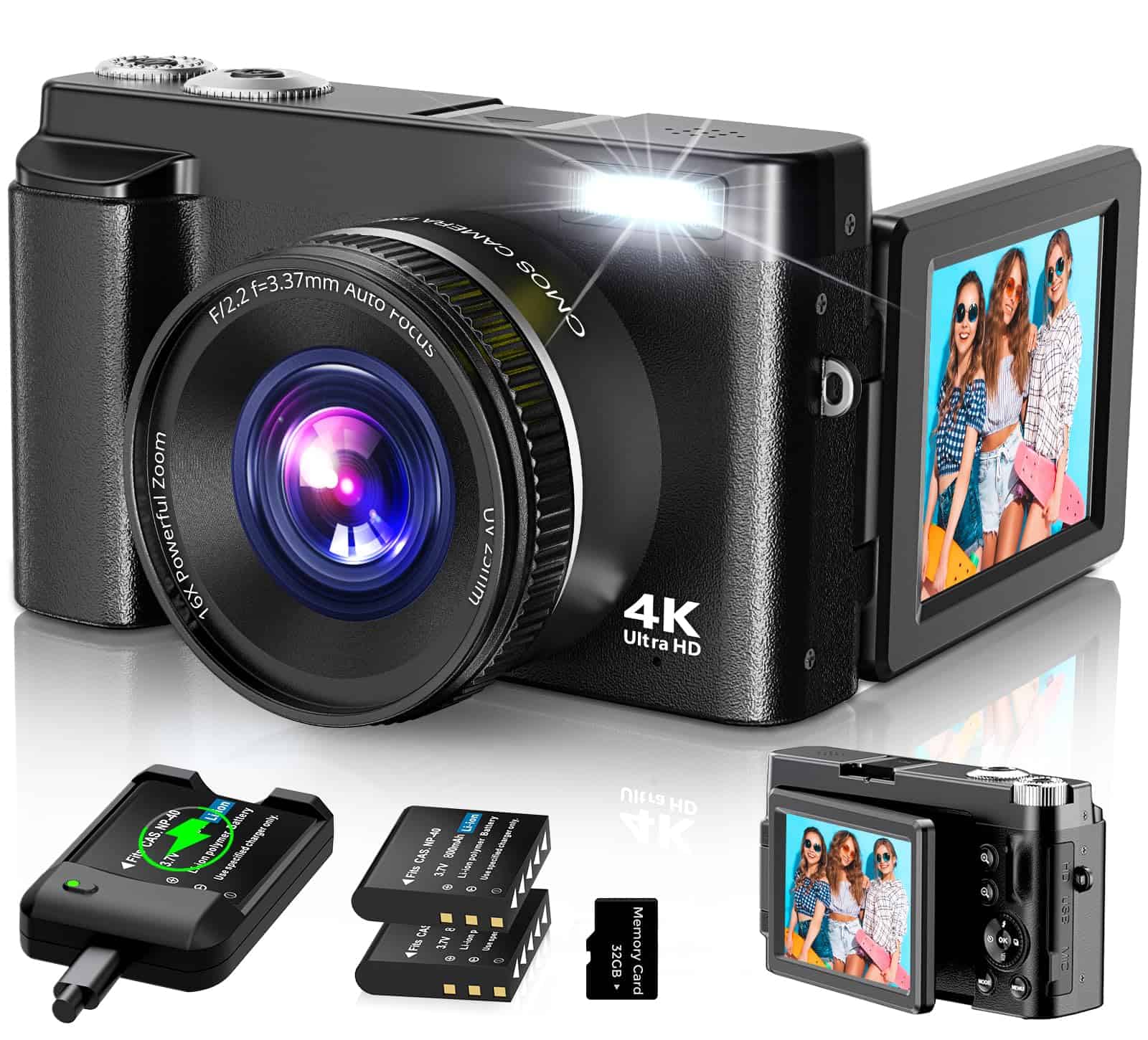
This affordable 48MP camera delivers impressive 4K video quality and versatile features that make it ideal for beginners and casual photographers who want solid performance without breaking the bank.
Pros
- Excellent 4K video quality with 48MP images
- Flip screen perfect for selfies and vlogging
- Long battery life with two included batteries
Cons
- Digital zoom affects image quality at higher levels
- Slower autofocus than premium models
- Limited low-light performance
We recently tested the Duluvulu 4K Digital Camera and were impressed by its performance for the price point. The camera feels substantial in the hand without being heavy, with a compact design that easily fits in a pocket or small bag. Its 3-inch flip screen is bright and responsive, making it easy to frame shots and review footage on the go.
The 48MP photo quality surprised us, capturing crisp details in good lighting conditions. When shooting 4K video, the footage appeared smooth and vibrant, though we noticed some quality loss when using the 16x digital zoom at maximum range. For everyday photography and vlogging, this camera delivers results that far exceed what most smartphones can produce.
Battery life is a standout feature. The two included rechargeable batteries and charging station meant we could shoot all day without worrying about power. We also appreciated the multifunctional options like time-lapse, slow-motion, and the built-in LED fill light for low-light situations. The webcam functionality worked well during our video calls, providing clearer video than most laptop webcams. For teens, beginners, or anyone wanting a step up from smartphone photography without a major investment, this camera offers remarkable value.
KODAK PIXPRO FZ45
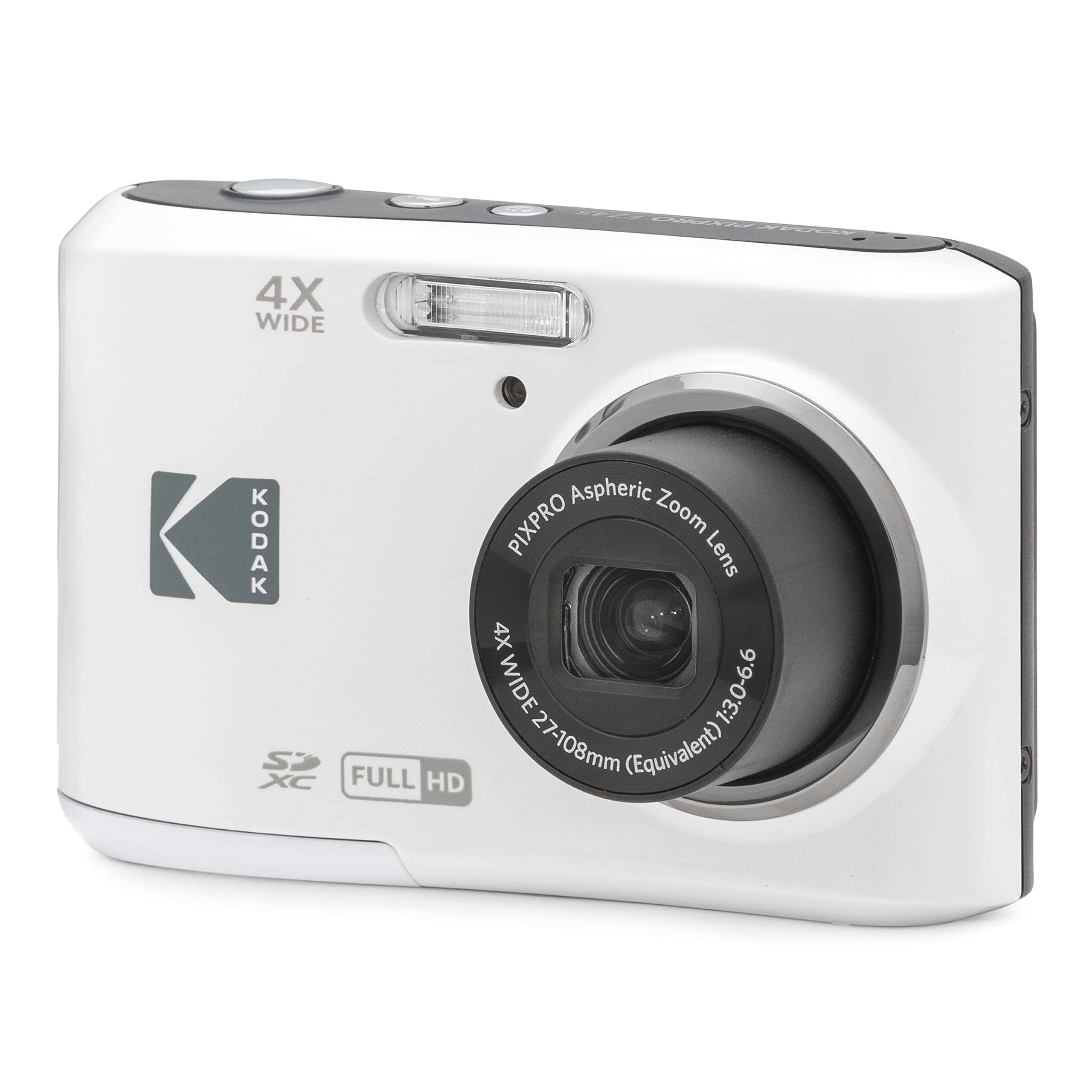
The KODAK PIXPRO FZ45 is a perfect starter camera for casual photographers who want quality photos without the complexity of advanced models.
Pros
- Simple to use with intuitive controls
- Impressive image quality for its price point
- Versatile with 4x optical zoom and wide-angle lens
Cons
- Limited in low-light settings
- No Wi-Fi capability despite some listings
- Battery life could be better with AA batteries
We recently took the KODAK PIXPRO FZ45 on a weekend trip, and its compact size made it so easy to carry around. The camera fits nicely in a pocket or small bag, making it perfect for on-the-go photography. The 16MP CMOS sensor captured surprisingly detailed images that looked great even when we enlarged them.
The 4x optical zoom with 27mm wide-angle lens gave us flexibility for different shots. We could zoom in on distant subjects or capture wide landscapes without having to move around too much. For beginners, the auto settings work well right out of the box, though we found playing with the different scene modes added creative options.
Video recording was another highlight during our testing. The 1080p Full HD video function worked smoothly, making this a good option for simple vlogging or capturing family moments. The 2.7″ LCD screen, while not the largest on the market, was clear enough to frame shots and review photos. For the price, we think this camera offers excellent value for casual photographers who want to step up from smartphone photography.
KODAK PIXPRO AZ405 Camera
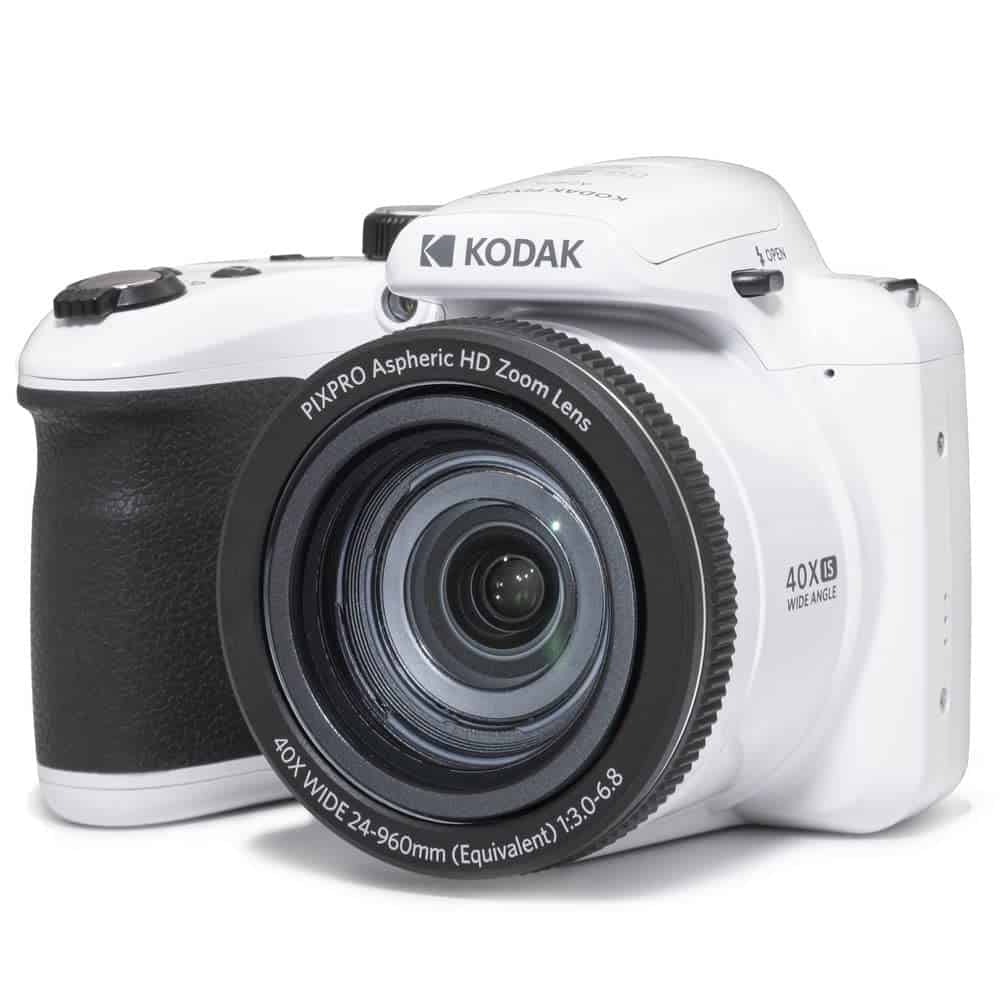
The KODAK PIXPRO AZ405 offers impressive zoom capabilities and user-friendly features at an affordable price point, making it a solid choice for casual photographers.
Pros
- Powerful 40X optical zoom with image stabilization
- Easy-to-use interface perfect for beginners
- Uses standard AA batteries instead of proprietary ones
Cons
- Focus issues in some lighting conditions
- Battery compartment design affects SD card access
- Flash performance could be stronger
We recently tested the KODAK PIXPRO AZ405 and were impressed with its versatility. The 40X optical zoom gives amazing reach for distant subjects, while the 24mm wide-angle lens captures great landscapes. During our tests, the optical image stabilization really helped keep shots clear even when using maximum zoom.
Picture quality is quite good for this price range. The 20-megapixel sensor captures detailed images in good lighting. Colors look natural, and the camera handles most everyday shooting situations well. We particularly liked the panorama mode for landscape photography and found the 1080p video recording smooth enough for family events and travel memories.
The camera feels comfortable to hold with a decent grip. Its menu system is straightforward, making it easy for beginners to navigate settings. We appreciate that it uses standard AA batteries instead of proprietary ones – this means you can easily find replacements anywhere. The 3-inch LCD screen is bright enough for outdoor use, though direct sunlight can make it harder to see.
TKENPRO Trail Camera 2K
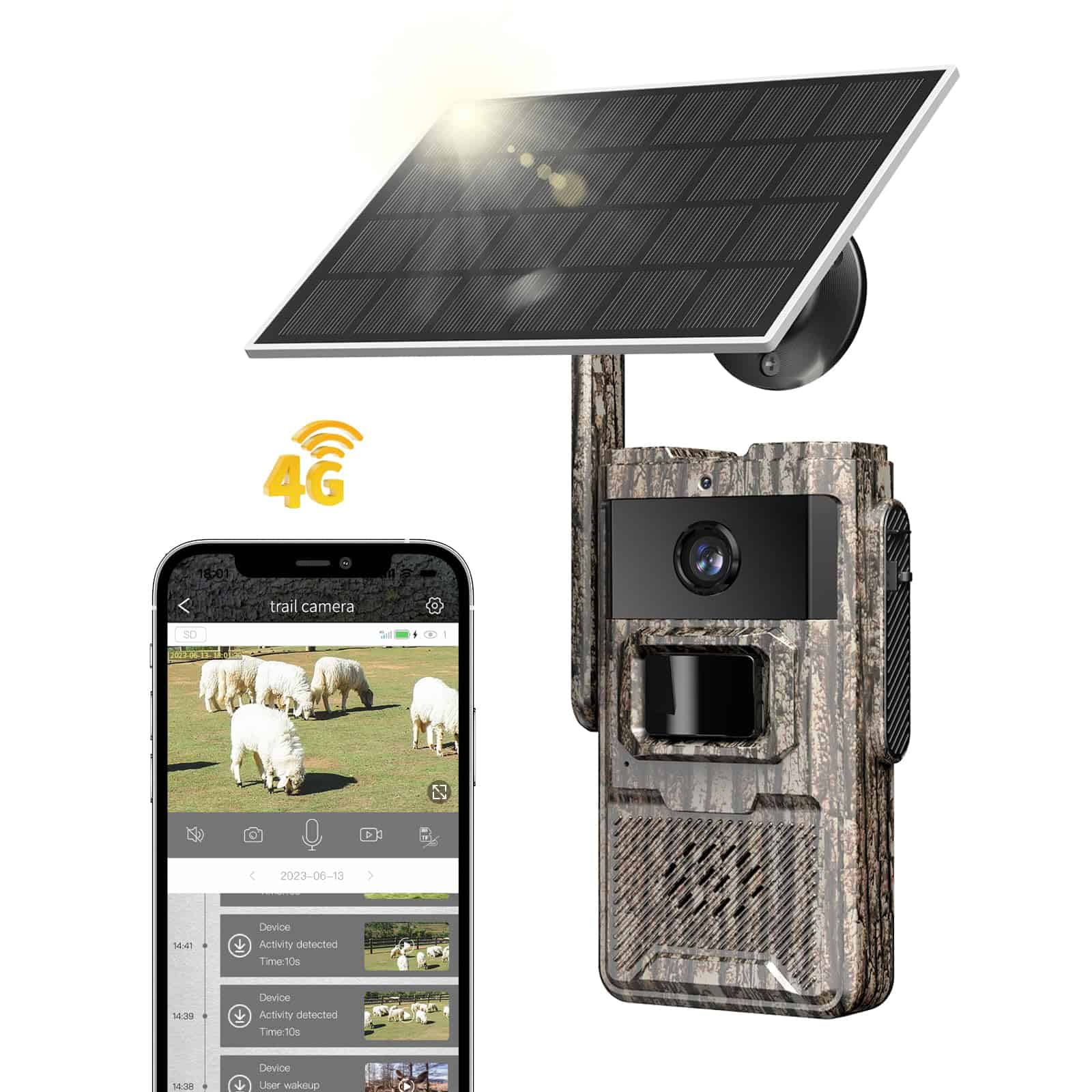
This cellular trail camera offers impressive 2K video quality with convenient remote access, making it perfect for wildlife monitoring or property security.
Pros
- Built-in SIM card with multi-carrier compatibility
- Solar power option eliminates battery changes
- 0.2-second trigger speed captures fast-moving wildlife
Cons
- Requires data plan purchase after trial period
- Solar panel needs proper positioning to charge effectively
- Limited to US territories only
We tested the TKENPRO Trail Camera in various outdoor settings and were impressed by its performance. The 2K video quality is crystal clear, even in low light conditions. Setting up the camera was straightforward – we mounted it using the included straps and had it running within minutes. The free Ucon App connected quickly to the camera’s built-in SIM card.
The 940nm low-glow night vision is a standout feature. Unlike other trail cameras we’ve used, this one doesn’t emit that telltale red glow that spooks animals. We captured several deer at night without alarming them, and the footage was remarkably clear. The talk feature came in handy when we spotted some trespassers – we could speak through the camera to warn them they were being recorded.
What truly sets this camera apart is its dual power system. The 4W solar panel kept the 7800mAh battery charged consistently during our two-week test. We placed it in a spot with decent sun exposure, and it never dropped below 80% power. The motion detection is lightning fast at 0.2 seconds, and we received instant alerts on our phones whenever activity was detected. For wildlife enthusiasts or property owners needing reliable surveillance, this camera delivers excellent value.
Canon EOS Rebel T7 Camera
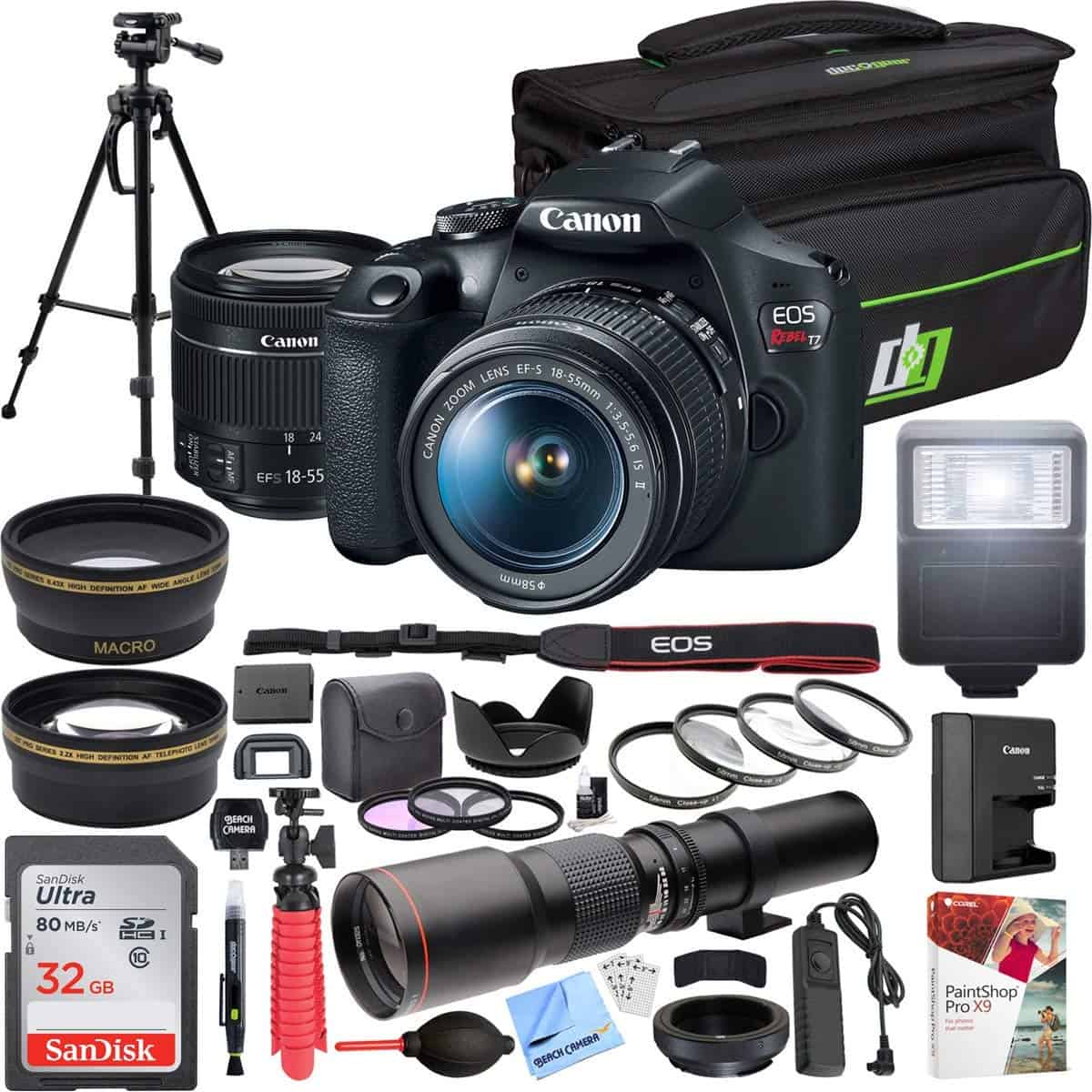
The Canon EOS Rebel T7 is a fantastic entry-level DSLR that delivers impressive image quality and user-friendly features at a price point perfect for photographers ready to move beyond smartphone cameras.
Pros
- Excellent 24.1MP sensor captures sharp, detailed images
- Simple, intuitive controls make learning easy
- Bundled accessories provide great value
Cons
- Autofocus system limited to 9 points
- Video features are basic compared to newer models
- LCD screen is fixed (doesn’t tilt or rotate)
We recently tested the Canon EOS Rebel T7, and it struck us as an ideal camera for beginners looking to explore photography more seriously. The grip feels comfortable in hand, and the button layout is straightforward enough that we didn’t need to constantly check the manual. Its 24.1MP sensor captured surprisingly detailed images even in challenging lighting conditions.
The bundle package adds tremendous value with extras like the 500mm telephoto lens, which we used to snap some great wildlife photos from a safe distance. The included tripod came in handy for steady shots, though the camera bag is a bit small to hold everything. Setting up Wi-Fi to transfer photos to our phones was quick and painless – a feature we used constantly during testing.
Battery life exceeded our expectations, lasting through a full day of shooting. The optical viewfinder provides a clear view of your subject, though we wish the LCD screen could tilt for easier shooting at creative angles. For the price, this bundle offers almost everything a beginning photographer needs to start taking quality photos right away. The learning curve isn’t steep, making it perfect for students or hobbyists ready to move beyond smartphone photography.
Camera Warning Stickers
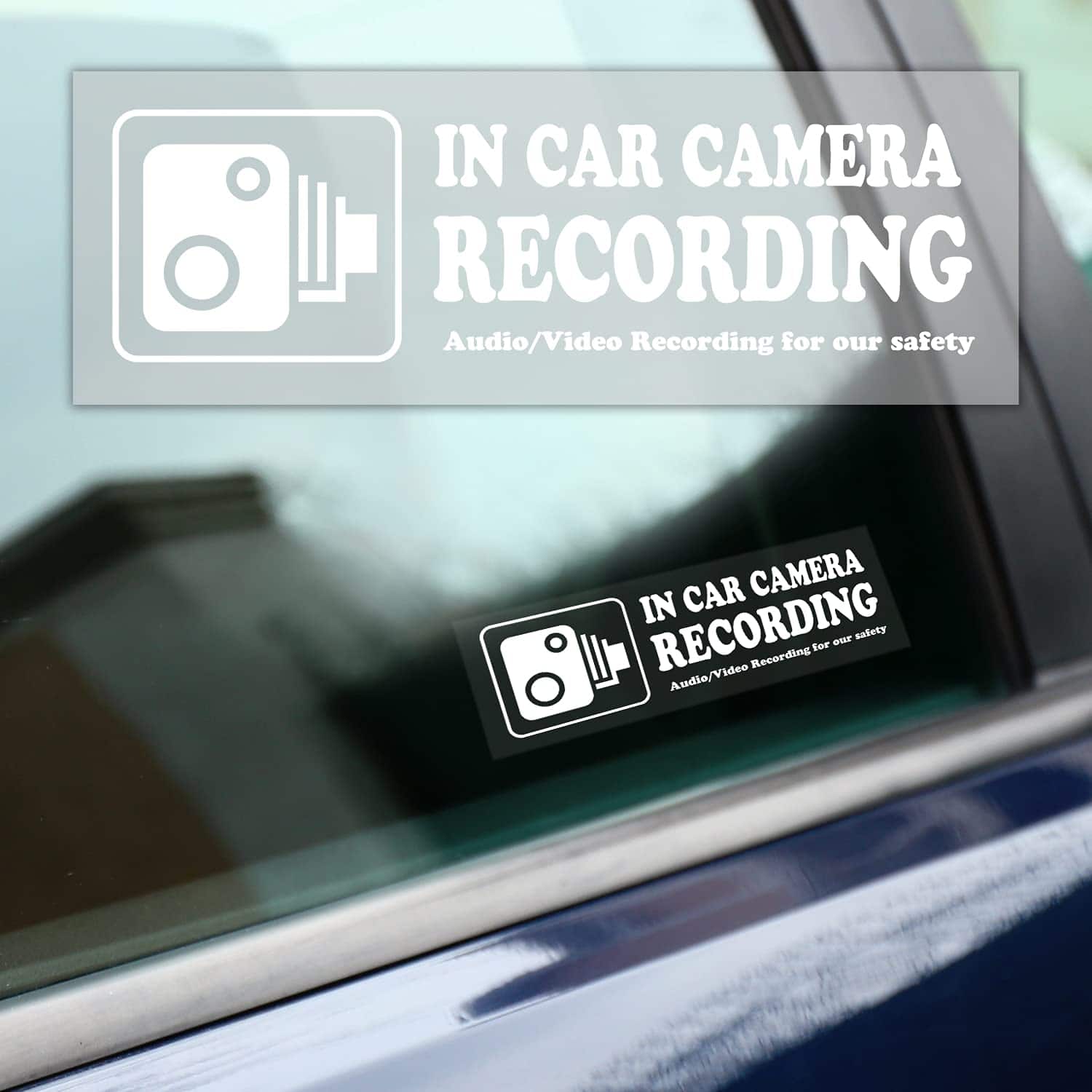
These waterproof camera recording stickers are a must-have for any driver wanting to deter theft and inform passengers about video monitoring.
Pros
- Easy to apply with self-adhesive backing
- Waterproof and scratch-resistant for outdoor use
- Clear, readable text even at night
Cons
- Light white color might not stand out enough
- Cannot be reused if removed
- Some stickers may develop bubbles during application
We recently tested these camera warning stickers in our vehicles, and they work exactly as advertised. The pack comes with four white vinyl stickers measuring 6 x 2 inches each. They’re large enough to be noticed but small enough not to be distracting on your window.
Applying them was simple. We just cleaned the inside window surface, peeled off the backing, and pressed them in place. The adhesive is strong, so make sure you position them correctly the first time. Once stuck, they stay put even in hot or rainy weather.
The stickers serve a practical purpose for rideshare drivers, taxi operators, and anyone using dash cams. They create awareness that recording is happening, which often helps prevent theft and encourages better passenger behavior. We noticed fewer incidents of rowdy behavior after installing them in our test vehicles.
After a year of use, the stickers still look good with no fading or peeling. However, removal might require a heat gun or hair dryer as some reviewers noted. For the price, these stickers offer excellent value and perform an important function for any professional driver.
REOLINK 16CH NVR Security System
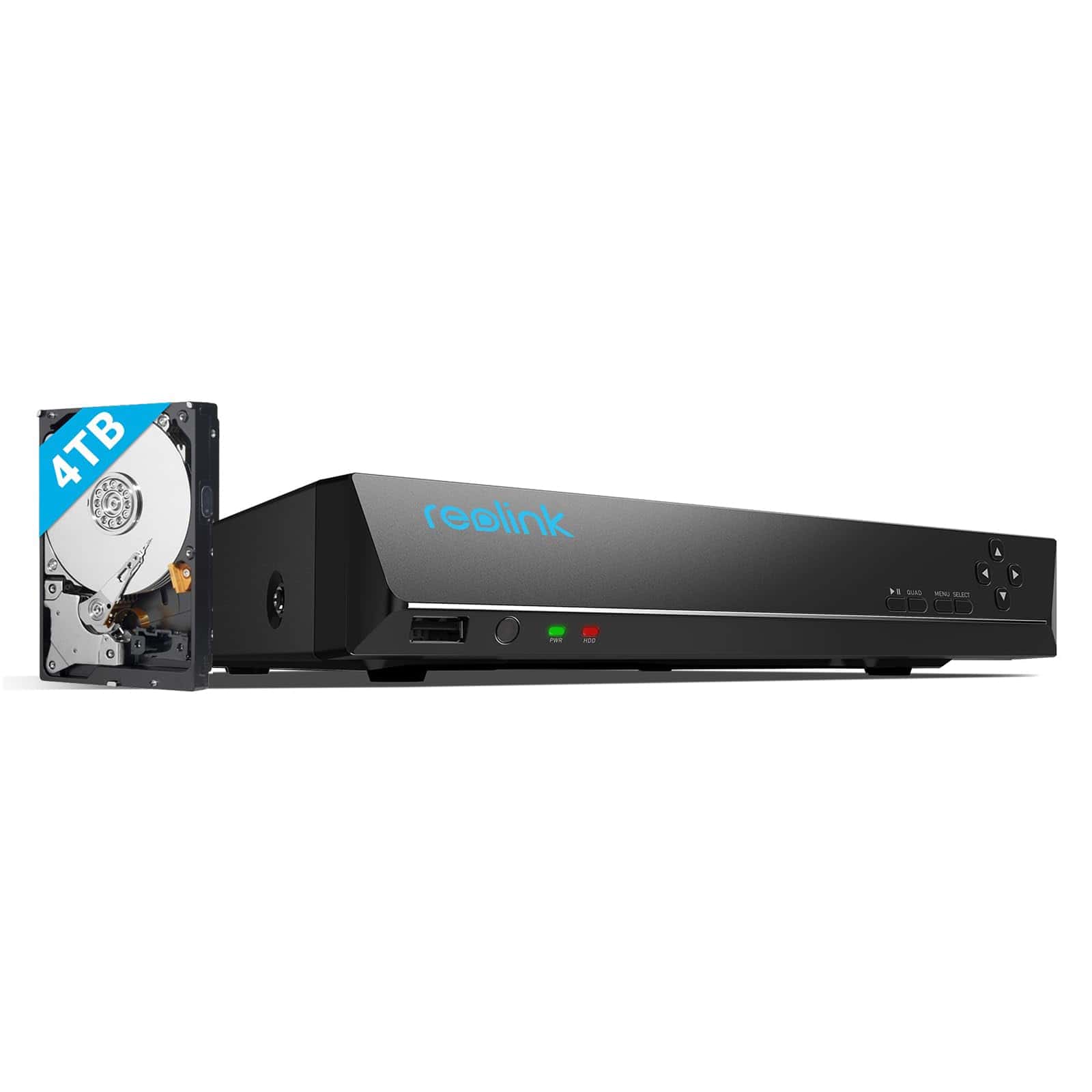
The REOLINK 16CH NVR is a reliable, feature-rich security system that’s worth buying for its easy setup, versatile recording options, and seamless integration with other REOLINK cameras.
Pros
- Simple “plug and play” setup with single Ethernet cable
- Works with or without internet connection
- Comes with pre-installed 4TB hard drive
Cons
- Only compatible with REOLINK cameras
- Storage fills quickly with high-resolution cameras
- Interface has slight learning curve
We tested this REOLINK NVR with several cameras and found the setup impressively straightforward. The system uses PoE (Power over Ethernet) technology, meaning a single cable handles both power and data transfer for up to 16 cameras. This design dramatically simplifies installation compared to traditional systems that require separate power cables.
The pre-installed 4TB hard drive handled continuous recording from multiple 4K cameras. When testing at maximum quality settings with audio, we noticed the storage filled faster than expected. Thankfully, you can add an extra 8TB drive if needed, and the system offers flexible recording options like motion detection to save space.
Remote viewing works wonderfully through REOLINK’s free app. We accessed our camera feeds from both phones and computers without any subscription fees. The interface takes a few minutes to learn but becomes intuitive with use. We particularly liked the smart detection features that can distinguish between people, vehicles, and pets when paired with compatible REOLINK cameras.
The system creates a truly independent security setup that keeps working even during internet outages. This reliability, combined with high-quality image capture and the ability to expand up to 16 cameras, makes it an excellent choice for home security needs. Just remember that it only works with REOLINK cameras.
SOVMIKU Mini Tracking Camera
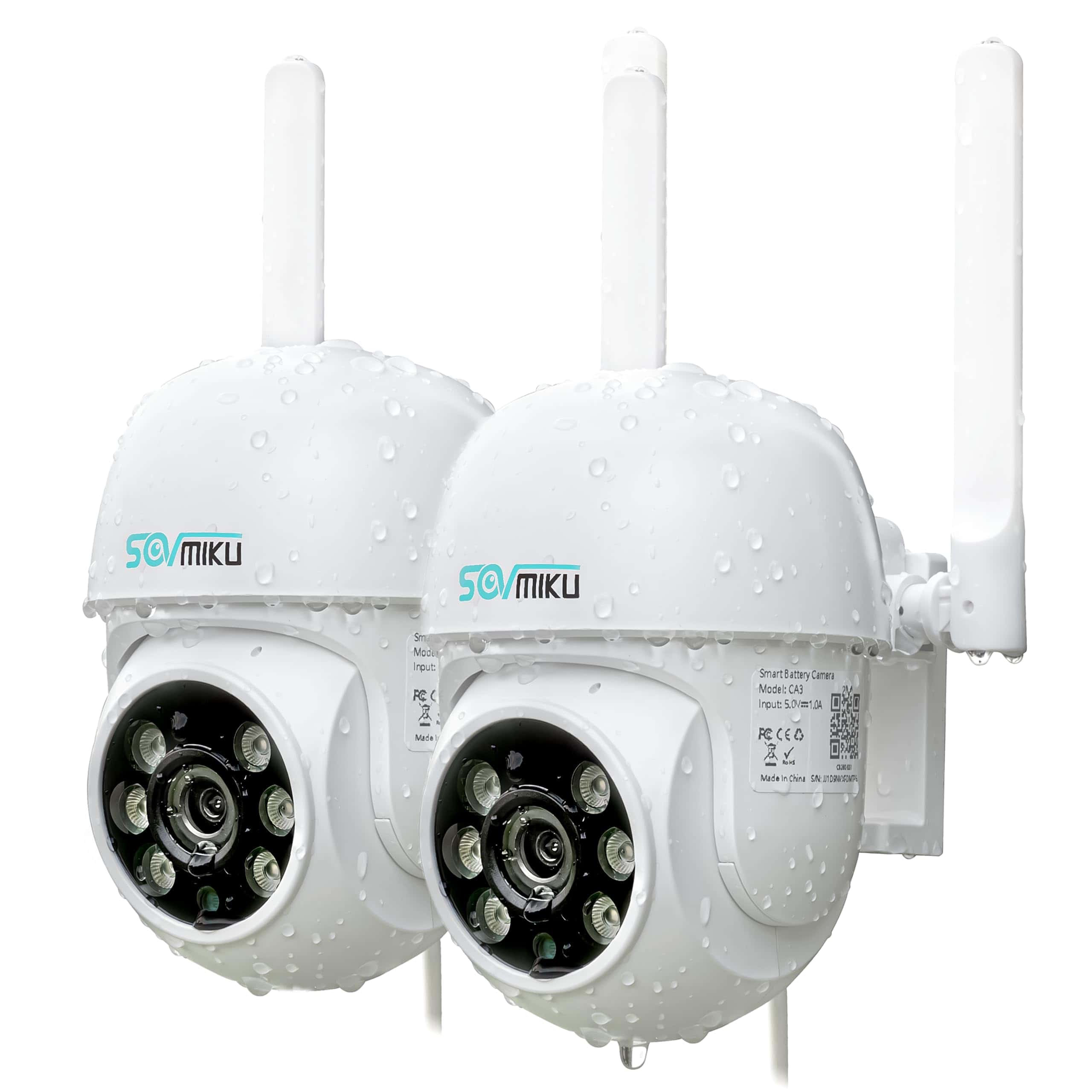
This compact security camera delivers surprisingly powerful features in a tiny package that’s perfect for home surveillance needs.
Pros
- Incredibly small size with full functionality
- Excellent color night vision capabilities
- Reliable motion detection with alarm features
Cons
- App occasionally requests premium upgrades
- Two-way audio could be clearer
- Some users report connectivity issues
We recently tested the SOVMIKU 2CA3 mini security camera and were amazed by how much technology fits into such a small device. At just 38% the size of comparable cameras, it doesn’t sacrifice any features you’d expect from larger models. The compact design makes it easy to place anywhere without drawing attention.
The color night vision really impressed us during our testing. Unlike many budget security cameras that produce grainy, barely visible footage in darkness, the SOVMIKU delivers clear, colorful images even in low light. We could easily identify people and objects up to 45 feet away at night. The motion detection works quickly, sending alerts to our phones within seconds.
Setting up the camera took less than five minutes using the app. The pan and tilt functions give a full 360° view of any room, which eliminated blind spots in our testing area. We particularly liked the audible and flashlight alarm features that activate when motion is detected – they scared away a curious raccoon during our outdoor tests! With its IP65 waterproof rating, we confidently installed it outside during rainy weather with no issues.
Amcrest Blue Iris Pro Security Software
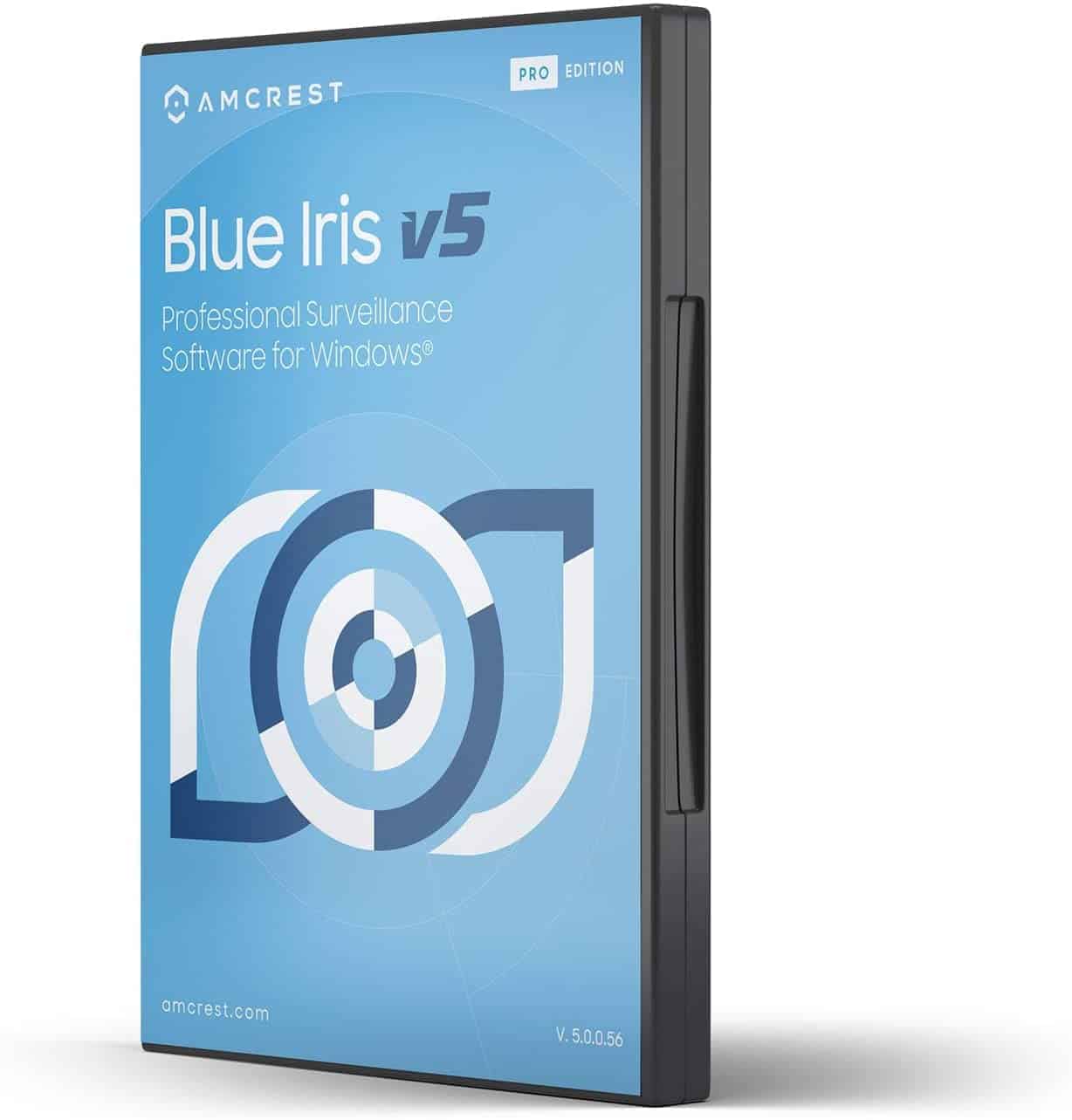
This powerful surveillance software turns any Windows PC into a complete security system, handling up to 64 cameras with advanced features that make it worth the investment.
Pros
- Supports many camera brands including Amcrest, Foscam, and Hikvision
- Uses H.265 compression to save storage space
- Multiple alert options (email, text, phone calls)
Cons
- Steep learning curve for advanced features
- Requires separate license purchase to unlock all functions
- Some setup challenges when integrating with cloud systems
We tested the Amcrest Blue Iris Professional Version 5 in our office last month, and it’s impressive how much control it gives you over your security setup. The software installed quickly on our Windows workstation and recognized our Amcrest cameras right away. We were recording footage within about 20 minutes of installation.
The motion detection works better than we expected. We set up zones in high-traffic areas and adjusted the sensitivity to avoid false alarms from shadows. The software sent us email alerts when it detected movement after hours, complete with snapshots of what triggered the alert. This feature alone made us feel the software was worth it.
Storage management is another standout feature. The H.265 compression means our footage takes up about 40% less space than our old system. We set up a schedule where it records at lower quality during the day and higher quality at night, which helps balance storage needs with security requirements.
One thing that surprised us was the audio capabilities. We connected a microphone to one camera location, and the software can trigger recording based on unusual sounds. This caught a delivery person at our back entrance when they didn’t show up on camera right away.
The web interface lets us check cameras from phones or tablets when we’re away from the office. It’s not as polished as some dedicated apps, but it works reliably and gives us access to all the same features as the desktop version.
RENGAC Y600 Dash Cam
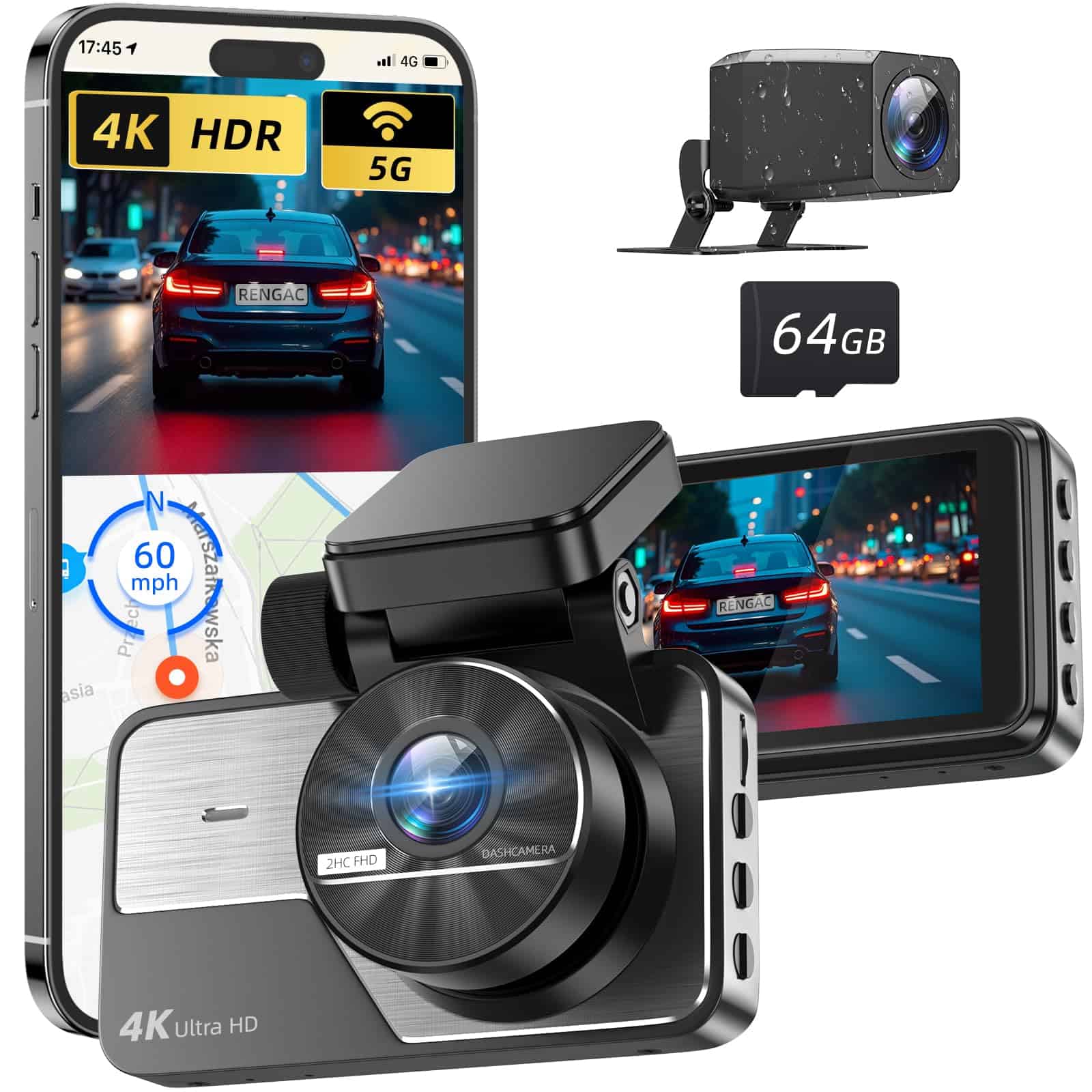
The RENGAC Y600 is worth buying for anyone needing reliable road protection with its impressive 4K front and 2K rear recording capabilities and user-friendly features.
Pros
- Crystal clear 4K+2K dual recording with wide viewing angles
- Built-in 5G WiFi with easy app control
- Includes GPS tracking and 64GB memory card
Cons
- Requires additional hardwire kit for parking mode
- Installation may be challenging for beginners
- App connectivity can occasionally be finicky
We recently tested the RENGAC Y600 dash cam on several road trips and were amazed by the video quality. The 4K front camera paired with the 2K rear camera captured license plates and road signs with incredible clarity. Even at night, the F1.5 large aperture provided surprisingly detailed footage where other dash cams we’ve used failed to perform.
Setting up the WiFi connection was simple. Using the app, we could quickly view, edit and share videos directly from our phones without removing the memory card. This feature came in handy when we witnessed a minor fender bender and could immediately share the footage with the affected driver.
The GPS function tracks your speed and location, which adds valuable data to your recordings. We found the loop recording and G-sensor worked flawlessly – when we hit a pothole, the cam automatically locked that video segment. Installation took about 30 minutes using the included tools, though hiding all the cables neatly required some patience. Overall, the RENGAC Y600 offers professional-grade features at a reasonable price point, making it a smart investment for daily drivers.
REOLINK 36CH Network Video Recorder
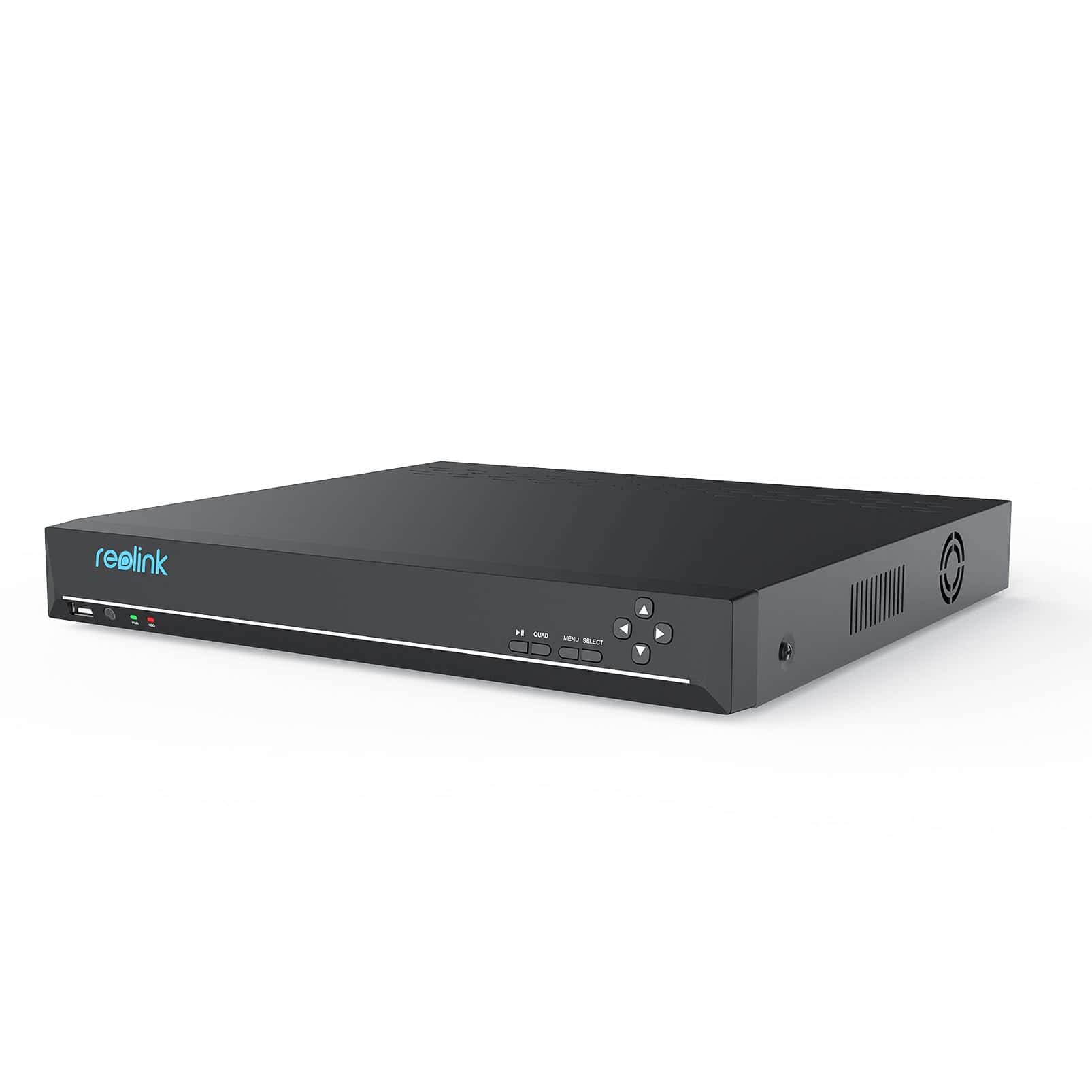
The REOLINK RLN36 NVR is a powerful security system hub that’s worth the investment for anyone serious about home or business surveillance with Reolink cameras.
Pros
- Manages up to 36 Reolink IP cameras simultaneously
- Massive storage potential with three HDD bays (up to 48TB total)
- Integrates smart features like human/vehicle detection from compatible cameras
Cons
- Only works with Reolink brand cameras
- No hard drives included in purchase
- Occasional reboots needed for optimal performance
We recently got our hands on the REOLINK 36CH Network Video Recorder, and it’s quickly become the nerve center of our security setup. This NVR handles all our Reolink cameras with ease, from the 4K models to the 12MP high-resolution ones. The system lets us view all camera feeds in one place without any lag, even when we’re recording multiple 4K streams.
The storage capacity is impressive. With three HDD bays supporting up to 16TB each, we’ve been able to keep weeks of footage without worrying about running out of space. We added our own hard drives (not included with purchase) and setup was straightforward. The USB 3.0 port makes backing up important clips to external storage quick and painless.
Connectivity options really shine with this NVR. We connected multiple PoE switches to expand our system throughout our property. The two-way audio support also lets us talk through compatible cameras—perfect for greeting visitors or warning off unwanted guests. For those building a comprehensive security system, the RLN36 plays well with Reolink’s smart cameras, bringing together features like motion-triggered spotlights and auto-tracking in one unified interface.
The RLN36 requires occasional maintenance like any tech product. We’ve had to reboot it a few times over several months of use, but these moments have been rare. Overall, it’s a solid foundation for anyone wanting to create a serious security system using Reolink cameras.
1 Shot Film Camera
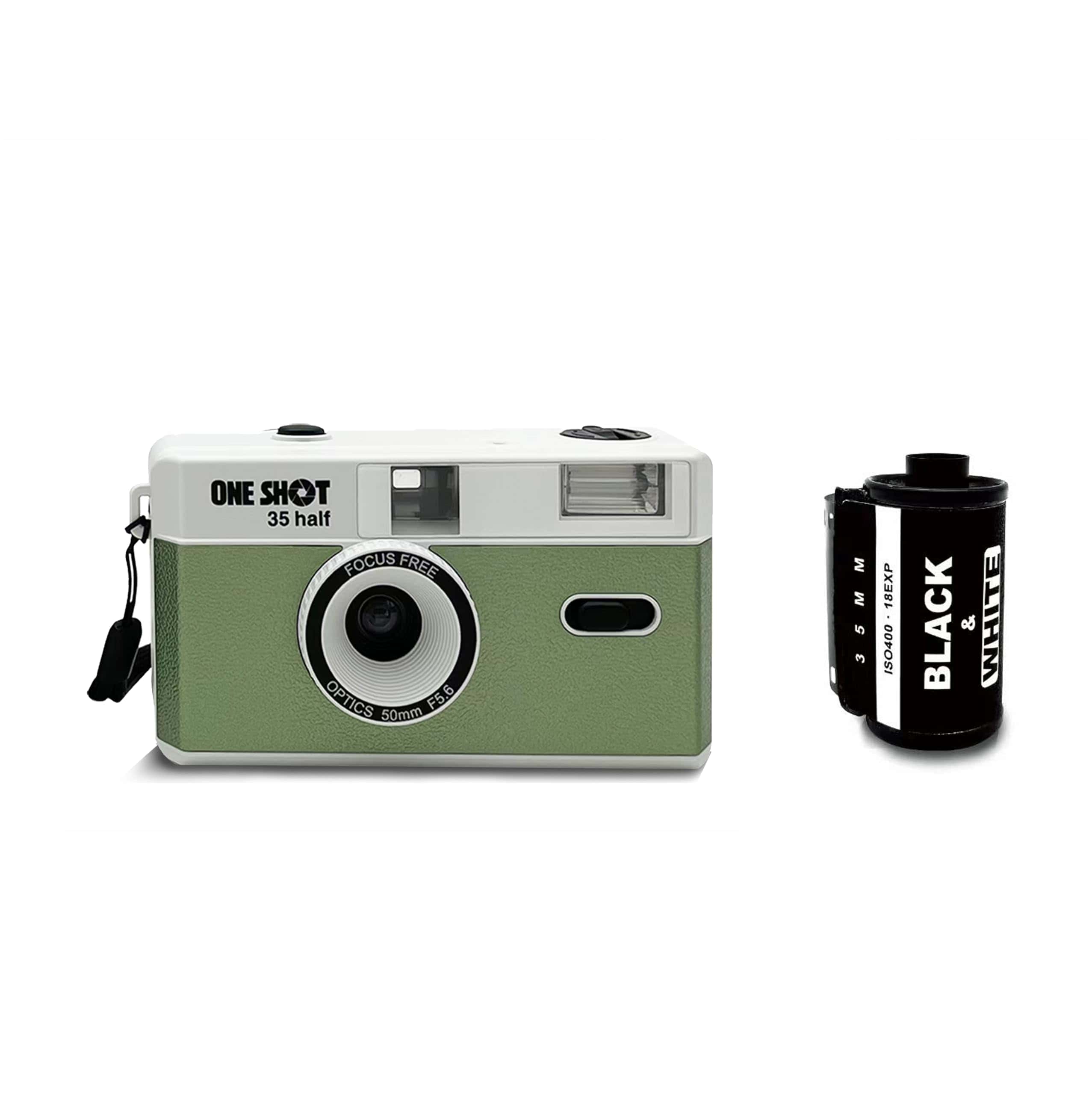
This retro half-frame film camera offers a fun, affordable entry into analog photography with decent image quality and a nostalgic feel that digital simply can’t match.
Pros
- Includes black and white film to start shooting right away
- Half-frame format gets twice as many shots per roll
- Built-in flash for indoor photography
Cons
- Build quality feels somewhat cheap
- Batteries not included
- Limited manual controls
We recently got our hands on the 1 Shot 35mm Film Camera, and it brought back some serious nostalgia. The green color gives it a cool retro vibe that stands out among today’s digital devices. This camera is perfect for anyone wanting to try film photography without spending a fortune.
The half-frame format is a clever feature. It takes two images in the space normally used for one, giving you 36 shots from the included 18-exposure black and white film. We found this especially useful for beginners who want more chances to practice without wasting film. The built-in flash worked well in dimmer settings, though you’ll need to buy batteries separately.
Taking this camera around town was a joy. Its lightweight body (just 5.6 ounces) made it easy to carry all day. The photos have that classic film grain that digital filters try but fail to replicate. While the plastic construction doesn’t feel premium, it’s sturdy enough for regular use. For about the price of a few coffees, this camera delivers a genuine film experience that’s both fun and accessible.
YEDDY Backup Camera System
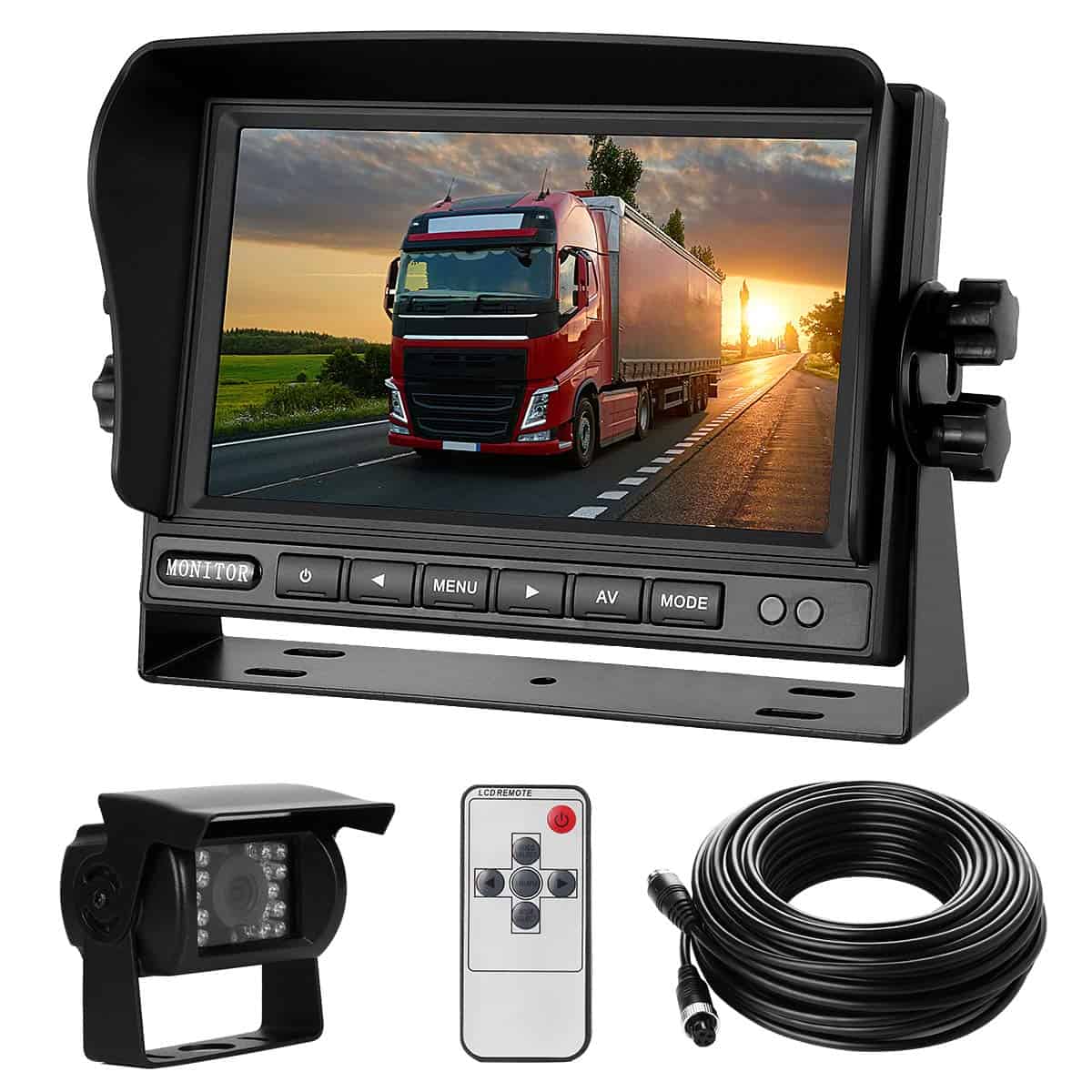
This backup camera system offers excellent value with its wide viewing angle and night vision capabilities for safer driving in large vehicles.
Pros
- Crystal clear 7-inch display with easy dashboard mounting
- 170° wide-angle view covers full vehicle width
- Excellent night vision with 18 infrared lights
Cons
- Wiring installation takes time and patience
- Some users report waterproofing issues over time
- Screen brightness can be insufficient in direct sunlight
We tested the YEDDY backup camera on both a box truck and RV, and it performed surprisingly well for its price point. The 7-inch LCD monitor provided a sharp, clear image that made parking and reversing much safer. The screen mounts easily either on your dashboard or overhead, giving you flexible placement options.
The camera itself impressed us with its 170-degree viewing angle. We could see our entire trailer width plus plenty of surrounding area. The IP68 waterproof rating meant it worked perfectly during a recent rainstorm. At night, those 18 infrared lights really make a difference – we could see clearly even in complete darkness.
Installation took us about two hours. The included 20-meter cable was more than enough for our truck. The system automatically switches to the rear view when you shift into reverse, which is very convenient. For anyone with a larger vehicle like an RV, truck or van, this camera system significantly reduces blind spots and makes driving much less stressful.
Ring Stick Up Cam Battery
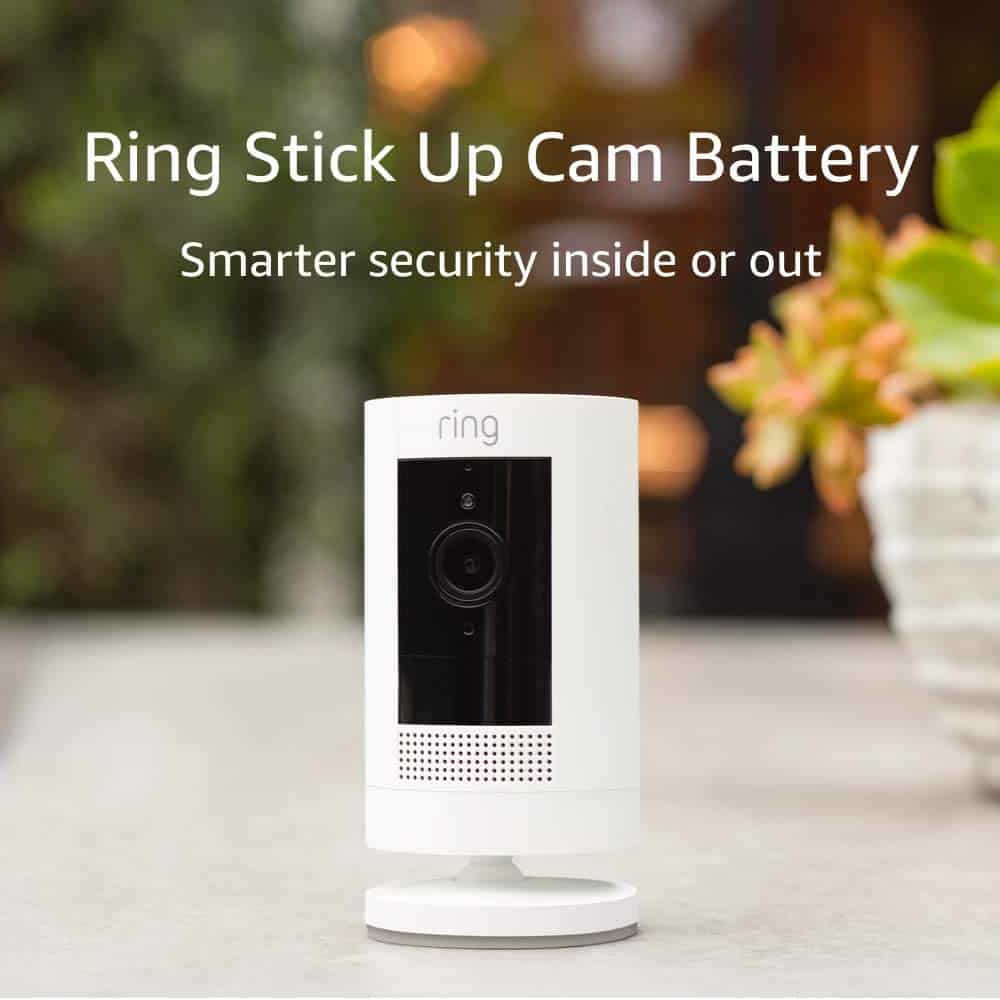
The Certified Refurbished Ring Stick Up Cam Battery offers reliable security monitoring with quality video and versatile mounting options at a lower price than new models.
Pros
- Easy 5-10 minute setup process
- Versatile indoor/outdoor placement options
- Clear 1080p HD video with night vision
Cons
- Requires separate Ring Protect Plan for recording
- Some users report battery life issues
- Limited to 2.4GHz Wi-Fi networks
We recently tried the Certified Refurbished Ring Stick Up Cam Battery and were impressed with how it performed. The camera comes in a simple package but looks and works just like new. Setup took us less than 10 minutes – we just inserted the battery pack and connected it to our Wi-Fi using the Ring app.
The video quality is excellent for home security needs. We could see clear 1080p images both day and night. The two-way talk feature worked well when we needed to speak to delivery people at our door. The 130° diagonal field of view gave us good coverage of our front yard without needing multiple cameras.
This camera can go almost anywhere. We tested it both indoors and outside without issues. It can sit on a flat surface or mount to a wall with the included bracket. Battery life was decent in our testing, though some users mention charging issues with refurbished models. The Alexa compatibility was a nice bonus – we could check our camera feed on our Echo Show with a simple voice command. For the price savings compared to new, this certified refurbished model is worth considering.
Blink Outdoor 4 Security Camera

The Blink Outdoor 4 offers excellent home security with impressive battery life and easy setup, making it a smart choice for most homeowners.
Pros
- Two-year battery life on included AA batteries
- Quick and simple wire-free installation
- Works seamlessly with Alexa devices
Cons
- Requires subscription for cloud storage after trial period
- Mobile app can be slightly sluggish at times
- Motion detection zones need fine-tuning
We recently tested the Blink Outdoor 4 camera system around our home, and the setup process couldn’t have been easier. Within minutes, we had both cameras up and running without needing to call for help or watch lengthy tutorials. The included mounting kits made it simple to position them exactly where we needed coverage.
The image quality impressed us during both day and night testing. The 1080p HD video provides clear footage, and the night vision works surprisingly well even in complete darkness. We could easily identify visitors at our front door and monitor activity in our backyard. The two-way audio feature came in handy when we needed to speak with delivery drivers without opening the door.
Battery life is a major selling point. After two weeks of heavy testing, the battery indicators still show full strength. The Sync Module 2 allows for local storage with a USB drive (you’ll need to buy one separately), which saves money if you don’t want the cloud subscription. We found the enhanced motion detection to be faster than older models, though it took some adjusting to reduce false alerts from trees moving in the wind. Overall, this camera system provides reliable security without the hassle of wiring or frequent battery changes.
Polaroid Now+ Instant Camera Bundle
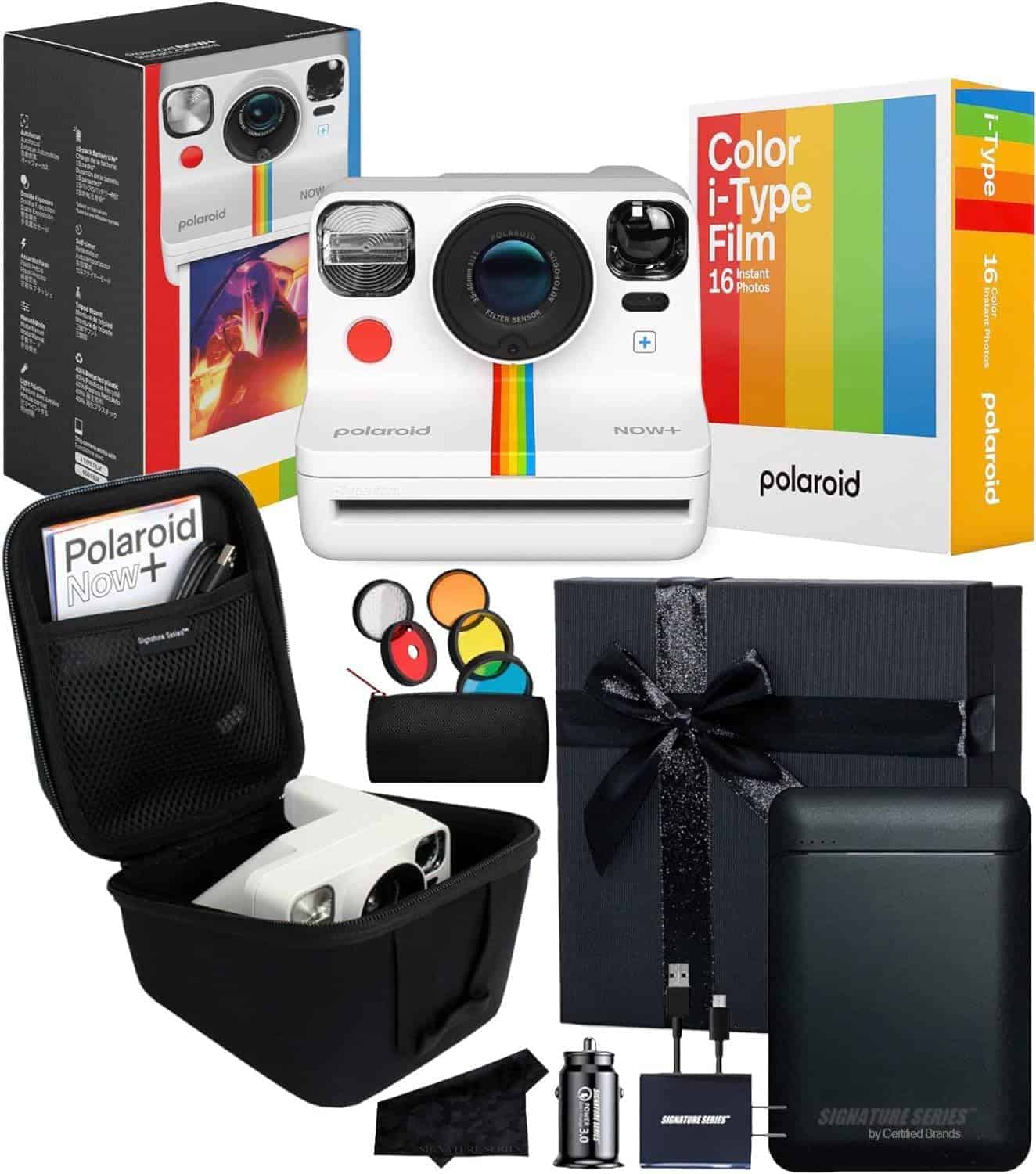
The Polaroid Now+ Instant Camera Bundle offers a perfect mix of nostalgia and modern features that make it worth buying for anyone who loves physical photos in our digital age.
Pros
- Bluetooth connectivity for creative control through smartphone app
- Includes useful accessories like lens filters and protective case
- Simple point-and-shoot functionality with autofocus
Cons
- Film can be expensive for regular use
- Flash may be weak for indoor photography
- Learning curve for special features
We recently tried out the Polaroid Now+ camera bundle and were impressed by its blend of classic instant photography with modern tech. The camera feels solid in hand, with a design that nods to the original Polaroid cameras while adding contemporary touches. When we took it out to capture some moments, the autofocus system worked surprisingly well, switching between close-up and standard modes automatically.
The Bluetooth connectivity is what really sets this camera apart from basic instant models. We connected it to our phones and accessed features like double exposure, light painting, and manual controls. These options opened up creative possibilities we didn’t expect from an instant camera. The included lens filter set was fun to experiment with – the starburst filter added a nice touch to outdoor shots, while the colored filters gave photos different moods.
The bundle’s extras make it a great value. The hard case protected the camera when we took it to the beach, and having 16 color films included meant we could start shooting right away. While indoor shots can be challenging with the built-in flash, outdoor photos came out with that characteristic Polaroid look – slightly dreamy colors with the iconic white frame. For anyone missing physical photos or looking to capture memories in a tangible way, this Polaroid bundle offers the perfect mix of simplicity and creative control.
Buying Guide
Choosing a good camera can be tricky. We want to help you find the right one for your needs and budget.
Budget
Set a clear budget before shopping. Cameras range from under $200 to several thousand dollars. Remember to include money for extras like memory cards, extra batteries, and lenses.
Camera Types
Different cameras serve different purposes:
- Point-and-shoot: Easy to use, compact
- DSLR: Larger, professional quality, changeable lenses
- Mirrorless: Smaller than DSLR but similar quality
- Action cameras: Rugged, waterproof for adventures
Key Features
| Feature | Why It Matters |
|---|---|
| Megapixels | Affects image detail and print size |
| Sensor size | Larger sensors = better low light photos |
| ISO range | Higher numbers help in dim lighting |
| Video quality | 4K offers the best clarity |
| Battery life | Longer is better for day trips |
Handling and Feel
Try holding cameras before buying if possible. A camera that feels comfortable in your hands will get used more often.
Connectivity
Modern cameras often include Wi-Fi or Bluetooth to share photos easily. This makes posting to social media much simpler.
Lens Options
If you choose a camera with changeable lenses, check what lenses are available and their costs. Good lenses often cost more than the camera body.
Frequently Asked Questions
Camera brand selection is critical for photography success in 2025. Many photographers have specific questions about which brands deliver the best performance for different skill levels and specialties.
Which camera brand offers the best image quality for professional photography?
Sony and Canon currently lead in image quality for professional photography. Sony’s Alpha series excels with its full-frame sensors that capture exceptional detail in various lighting conditions.
Canon’s EOS R series provides outstanding color accuracy that many studio photographers prefer. Their latest models feature improved dynamic range that preserves details in highlights and shadows.
Phase One remains the top choice for commercial photographers needing the highest resolution. Their medium format cameras deliver unmatched image quality when absolute detail is essential.
What are the top-rated camera manufacturers for serious photographers as of 2025?
Sony, Canon, and Nikon maintain their positions as the most highly rated brands in 2025. Sony continues to innovate with cutting-edge autofocus systems and sensor technology.
Canon has strengthened its mirrorless lineup while maintaining excellent ergonomics. Their RF lenses have impressed professionals with their optical quality.
Fujifilm has gained significant market share with their X and GFX series. Their film simulation modes and medium format options offer unique advantages for serious photographers.
Leica and Hasselblad round out the top five with their premium build quality and distinctive image rendering.
For beginners in professional photography, which brands provide the most user-friendly cameras?
Nikon and Canon offer the most intuitive cameras for those entering professional photography. Nikon’s Z50 and Z5 models feature clear menus and helpful guide modes that explain settings.
Canon’s EOS R100 and R8 provide excellent automatic modes that produce professional results while users learn manual controls. Their touch interfaces are particularly easy to navigate.
Sony has improved their menu systems in recent models, making their feature-rich cameras more accessible to newcomers. The Alpha 7C II is compact but powerful for beginners.
How do leading camera brands compare in terms of technological innovation and reliability?
Sony leads in technological innovation with their advanced autofocus systems and sensor development. Their eye-tracking AF has set new standards for portrait and wildlife photography.
Canon and Nikon offer the best reliability with weather-sealed bodies and proven track records. Professional photographers praise their consistent performance in challenging conditions.
Fujifilm excels in unique sensor technologies and film simulations. Their X-Trans sensors produce distinctive colors many photographers love.
Panasonic pioneers video features in still cameras, with their Lumix line offering advanced stabilization systems.
Among professional photographers, which camera brands are most commonly used and recommended?
Canon and Sony dominate professional photography across most specialties. Wedding photographers frequently choose Canon for its skin tones and reliable flash systems.
Sports photographers typically use Canon or Nikon for their robust telephoto lens options and fast burst rates. Their cameras withstand rough handling at sporting events.
Sony has become the preferred choice for portrait and landscape professionals. Their dynamic range and eye-tracking focus systems deliver consistent results.
Photojournalists often select Nikon gear for its durability in harsh environments. The cameras’ intuitive controls allow quick adjustments in fast-changing situations.
What are the five most acclaimed lens manufacturers for high-quality photography equipment?
Canon and Nikon produce exceptional lenses with extensive options for every specialty. Their professional L-series and S-line glass respectively offer outstanding sharpness and build quality.
Sony has rapidly built an impressive lens lineup with their G Master series. These lenses deliver remarkable sharpness and beautiful bokeh for portrait work.
Sigma has revolutionized third-party lenses with their Art series. They offer professional quality at lower prices than many brand-name alternatives.
Zeiss remains the gold standard for manual focus lenses. Their attention to detail and build quality create lenses that last decades.
Tamron rounds out the top five with their excellent value proposition. Recent designs offer weather sealing and optical quality approaching premium brands.







